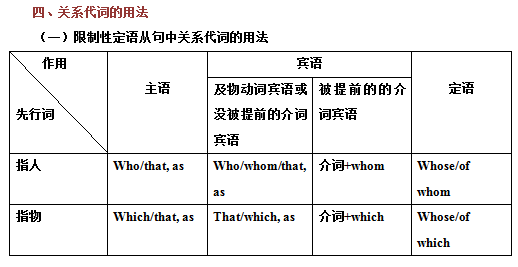when|九年级英语定语从句完整归纳讲解及练习
江苏龙网_原题是:九年级英语定语从句完整归纳讲解及练习
初三定语从句的用法和精练
一、定语从句的概念
在复合句中, 修饰某一名词或代词的从句叫定语从句 。 被修饰的名词或代词叫先行词,定语从句一般放在先行词后 。
二、定语从句的关系词
引导定语从句的关系词有关系代词和关系副词,常见的关系代词包括that, which, who(宾格whom,所有格whose)等,关系副词包括where, when, why等 。 关系代词和关系副词放在先行词及定语从句之间起连接作用,同时又作定语从句的重要成分 。
三、定语从句的分类
根据定语从句与先行词的关系,定语从句可分为限制性定语从句及非限制性定语从句 。 限制性定语从句紧跟先行词, 主句与从句不用逗号分开,从句不可省去 。 非限制性定语从句主句与从句之间有逗号分开,起补充说明作用,如省去,意思仍完整 。

文章图片
1. that 既可以用于指人,也可以用于指物 。 在从句中作主语或宾语,作主语时不可省略,作宾语可省略 。 例如:Mary likes music that is quiet and gentle. 玛丽喜欢轻柔的音乐 。 (that 作主语) The coat (that) I put on the desk is blue. 我放在桌子上的那件外套是蓝色的 。 (that作宾语)
2.which 用于指物,在句中作主语或宾语,作主语不可省略,作宾语可省略 。 例如: The building which stands near the train station is a supermarket. 位于火车站附近的那座大楼是一家超市 。 (作主语) The film (which) we saw last night was wonderful. 我们昨天晚上看的那部电影很好看 。 (作宾语)
3.who, whom 用于指人,who 用作主语,whom用作宾语 。 在口语中,有时可用who代替whom, 也可省略 。 例如: The girl who often helps me with my English is from England. 经常在英语方面帮助我的那个女孩是英国人 。 ( 作主语) Who is the teacher (whom) Li Ming is talking to? 正在与李明谈话的老师是谁?( 作宾语)
注意:
(1) 当定语从句中含有介词,介词放在句末时,who, that, which可省略,但介词在关系代词前时,只能用“介词 +which/whom”结构 。 例如:
This is the house in which we lived last year. 这是我们去年居住的房子 。 Please tell me from whom you borrowed the English novel. 请告诉我你从谁那借的这本英文小说 。
(2) 含有介词的固定动词词组中, 介词不可前置,只能放在原来的位置上 。 例如: This is the person whom you are looking for. 这就是你要找的那个人 。
(3)that 作介词的宾语时,介词不能放它的前面,只能放在从句中动词的后面 。 例如: The city that she lives in is very far away. 她居住的城市非常远 。
(4)关系词只能用that 的情况:
a. 先行词被序数词或形容词最高级所修饰,或本身是序数词、基数词、形容词最高级时,只能用that,而不用which.例如: He was the first person that passed the exam. 他是第一个通过考试的人 。
b. 被修饰的先行词为all, any, much, many, everything, anything, none, the one等不定代词时,只能用that,而不用which.例如: Is there anything that you want to buy in the shop? 你在商店里有什么东西要买吗?
c. 先行词被the only, the very, the same, the last, little, few 等词修饰时,只能用that,而不用which.例如: This is the same bike that I lost. 这就是我丢的那辆自行车 。
d. 先行词里同时含有人或物时,只能用that, 而不用which.
例如: I can remember well the persons and some pictures that I saw in the room.
推荐阅读
- the|四六级 | 四六级备考 | 2016年12月英语四级听力真题及答案:第2套
- 本科为英语专业,毕业两年从事外贸,现在想进入腾讯,想问下腾讯相应的岗位有哪些,还有咋才能被录用
- 给日本人用英语发邮件,该咋称呼对方
- kt|高考英语:必考单词大全A系列!高中生必看!
- web前端对英语有要求吗
- 复习|七年级英语期末阅读理解专项复习5篇及答案解析
- 高三生|写给2021届高三生!高考英语复习7大攻略
- IT从业者需要达到怎么样的英语水平
- Bto|高一高二高三学生必须掌握的英语过去完成时练习题及答案解析
- 英语|考试题型有变?技巧丨2021年各省英语听说考提前
















